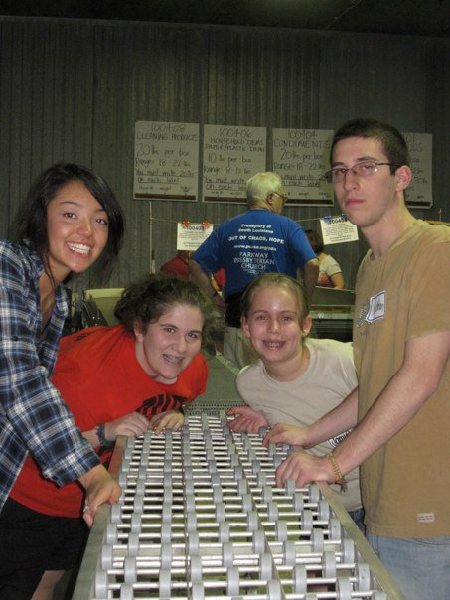By Janis Siegel, JTNews Correspondent
Ten-year old Heather Johnson donned the special work gloves her mother bought just for her, and got serious about the tasks she was given at the old, flood-ravaged home in New Orleans where she came to work.
As the youngest member of Temple De Hirsch Sinai’s “voluntourism” trip to the “Big Easy” in April of this year, she knew there was a lot to do, even though it’s been five years since Hurricane Katrina hit.
“I helped plant flowers and I also helped weed,” Heather, a student at Eaton School, told the JTNews. Her mother and father also went with her on the trip, and made sure she was given appropriate “little girl” activities.
“I also worked at a food bank,” she said. “I’m really good at sorting food.”
Heather first saw the hurricane’s devastation in 2006, on a trip she took with her parents soon after it made landfall. Now, she returned with a mission.
“Everything didn’t look so pretty,” said Heather, thinking back on her first time there. “They didn’t have that many people. But this felt really good because they need the help. They looked happy that we helped them. “
This is TDHS’s second trip to New Orleans to help with cleanup and construction in some of the poorest wards in New Orleans devastated by the hurricane.
Last year, Rabbi Alan Cook, associate rabbi at Temple De Hirsch Sinai, and TDHS education and youth director Leah Rosenwald acted as chaperones and took 11 teens and three young adults to the Lower 9th Ward.
This year they went back with a group of 26, ranging in ages between 10 and 73, including members from The Tribe, a temple group of young adults whose ages range from 25 to 35. Nearly half of the group were families.
“We worked with residents of the lower 9th ward, which is predominantly an African-American community, to rebuild the community that was devastated by Hurricane Katrina,” Cook said. “We also did some visiting in the 5th Ward. They are also impoverished, but the community has not given them as much attention.”
The trips are subsidized in part by the congregation, but costs are shouldered mainly by the individual families at about $1,000 per person for five days. Voluntourists can expect to work with residents on the ground, helping them with painting, landscaping, building fences, repairing porches, installing sinks, or just about anything to do with home repair.
Cook also builds in some fun activities for the group. During their leisure time this year, the group went to a basketball game at the Astrodome, a bowling and dance party, a Rock Shabbat, one of TDHS’ popular Shabbat services, at the largest Reform temple in New Orleans, and Sunday services and lunch at the Baptist Missionary Church.
“We patronized two of the Jewish delis in town,” said Cook. “We had Shabbat at Congregation Gates of Prayer, one of the oldest Reform congregations, in Metairie, Louisiana. we took a driving tour of destroyed synagogues, and we explored the French Quarter.”
Cook was connected to a community group in New Orleans called the Lower 9th Ward Center for Sustainable Engagement and Development, whose offices are located at a church there.
Local homeowners submitted projects for which they needed help to the church staff, who then assigned the work to the volunteers for that day.
Lisa Frank Johnson, Heather’s mom, told JTNews that they’ve done community service with their daughter before, but it was nothing like this. Her husband also wanted to do this as a family project.
“We had seen the devastation the year after the hurricane,” said Johnson. “I was walking around the French Quarter and it was deserted. The place was just shut down.
“Now, it’s open, and revitalized, and it doesn’t smell like mildew. Now, it looks great. There were tons of tourists, tons of shops, and tons of restaurants open.”
The whole family helped the new owner of an historic, 1800s-era house reposition a huge cement block back into its original spot, where it rested before the flooding, at the entryway of the home. They also replaced a sidewalk washed away during the storm.
“They can’t afford to hire people, they are mostly poor, and they don’t have the funds to do the work themselves,” said Johnson. “They were telling us that the first money that came through wasn’t enough to do any type of repair and a lot of these people had to use it to make their mortgage payments.
“Then,” she went on, “a lot of people gave money to gypsies that came in from Alabama who collected the money up front to do the work but absconded with a lot of the cash.”
Cook is already planning next year’s trip and will bring people outside of the congregation who might want to come.
Johnson hopes that between now and next year’s trip, the temple can bring in a construction professional to teach the participants house-building skills such as how to hang drywall, how to do framing, and how to install windows. Without those skills, said Johnson, it limited the work they were able to do.
However, because so many people in New Orleans are still so eager for volunteers, said Cook, and because it’s one of the few opportunities in which organizations can participate that doesn’t have age restrictions, it’s a good fit for TDHS.
He also believes it’s also a great way to immerse the temple youth in real-life, real-time charity.
“We wanted them to go from bringing in a quarter or two for tzedakah on a Sunday morning, to showing them the recipients of tzedakah and that there is a great need in this world,” said Cook. “For some of them last year, this was the first time they had been on an airplane, or had seen poverty, social striations, and racial divisions firsthand. “Hopefully, you’ve made an impact and they see there is a great need in the world.”
